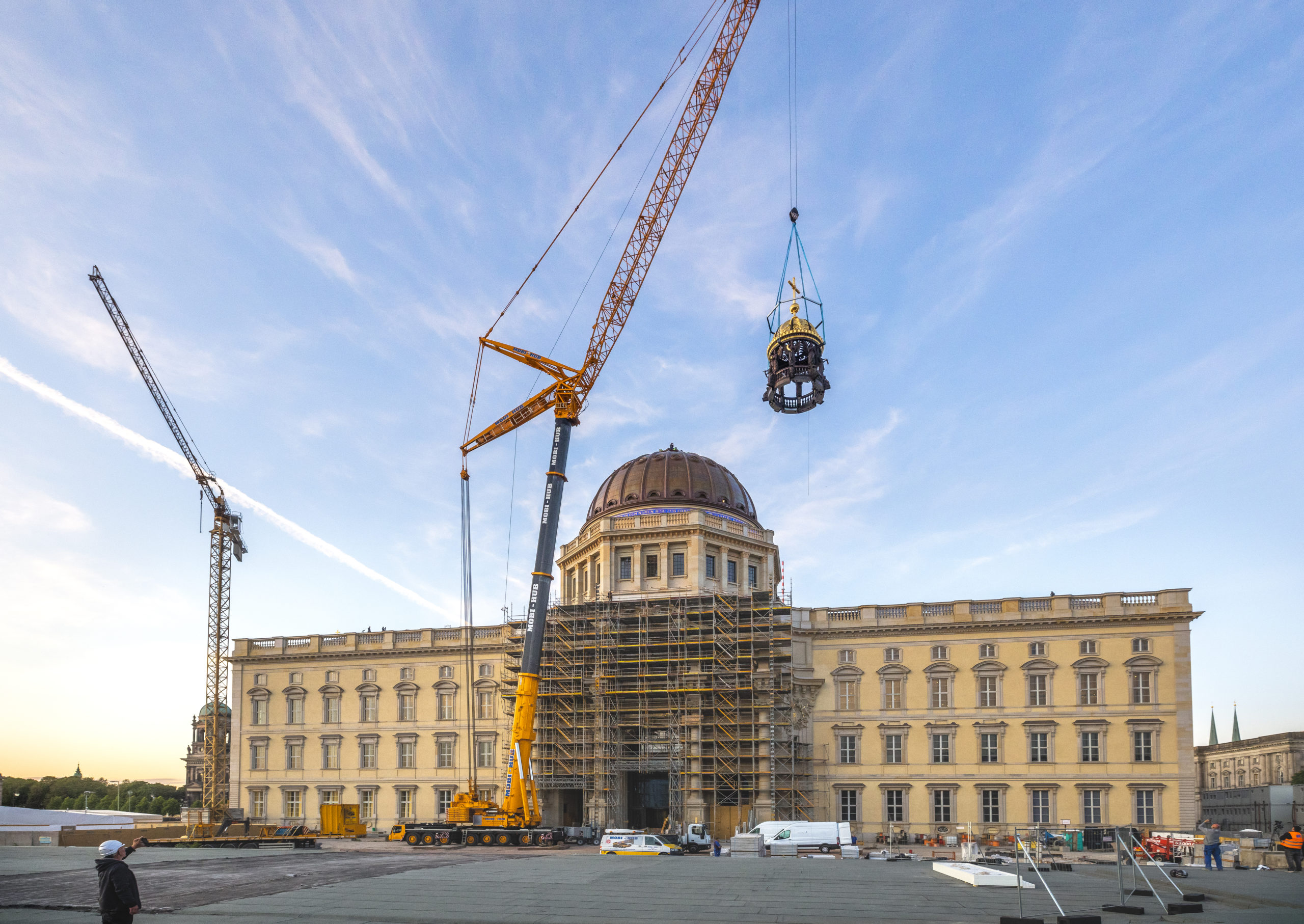Uwe Altrock, ed., Identität durch Rekonstruktion? Positionen zum Wiederaufbau verlorener Bauten und Räume, Öffentliche Baukulturwerkstatt (Berlin: Bundesministerium für Verkehr, Bau- und Stadtentwicklung, 2009).
See ➝.
Richard Pommer, “The Flat Roof: A Modernist Controversy in Germany,” in “Revising Modernist History: The Architecture of the1920s and 1930s,” special issue, Art Journal 43, no. 2 (Summer 1983), 158–169.
Because German reunification in 1990 was not an agreement between two partners but rather the annexation of the smaller and economically weaker East Germany to West Germany, I take the liberty of limiting my discussion of the period prior to 1989 to West Germany.
Deborah Ascher Barnstone, The Transparent State: Architecture and Politics in Postwar Germany (London: Routledge, 2005).
Aleida Assmann, Das neue Unbehagen an der Erinnerungskultur: Eine Intervention, 3rd ed. (Munich: C. H. Beck, 2020), 42–49. She refers here to the philosopher Hermann Lübbe’s theses of 1983.
Maximilian Liesner et al., eds., Paulskirche: Eine Politische Architekturgeschichte (Stuttgart: avedition, 2019), 79.
Wolfgang Pehnt, Gottfried Böhm, Studio-Paperback (Basel: Birkhäuser, 1999), 138–141; Wolfgang Voigt, ed., Gottfried Böhm (Berlin: Jovis, 2006), 22–30. Baumgarten even proposed reconstructing the dome, but the client did not want it, and it never happened. See Paul Baumgarten et al., eds., Paul Baumgarten: Bauten und Projekte, 1924–1981, Schriftenreihe der Akademie der Künste 19 (Berlin: Akad. d. Künste, Abt. Baukunst, 1988).
On this, see, among others, Oscar Schneider, Kampf um die Kuppel: Baukunst in der Demokratie (Bonn: Bouvier, 2006); Norman Foster, Rebuilding the Reichstag, ed. David Jenkins (London: Weidenfeld and Nicolson, 2000); and Bernhard Schulz and Norman Foster, The Reichstag: The Parliament Building by Norman Foster (Munich: Prestel, 1999).
Behnisch & Partner, Plenarbereich des Deutschen Bundestages in Bonn: Ausstellung Oktober, November 1992, Aedes, Galerie und Architekturforum (Berlin: Aedes, Galerie und Architekturforum, 1992).
Nino Galetti, Der Bundestag als Bauherr in Berlin: Ideen, Konzepte, Entscheidungen zur politischen Architektur, 1991–1998, Beiträge zur Geschichte des Parlamentarismus und der politischen Parteien 152 (Düsseldorf: Droste, 2008). He cites on page 69 a statement on the question of the temporary solution by Burkhard Hirsch, Minister of the Interior of North Rhine–Westphalia, from February 1980.
For more detail on this subject, see Philipp Oswalt, “Utopien und ihre Rekonstruktion,” in Nationalgalerie: “How German Is It?,” ed. Thomas Demand and Udo Kittelmann (Frankfurt am Main: Suhrkamp, 2011), 324–32.
The Belgian architect Léon Krier and the British philosopher Roger Scruton are two especially internationally prominent figures in this debate.
Christian Tröster, “Hans Stimmann, der Sarrazin der Architektur,” Die Welt, November 18, 2010.
“‘Ich bin ein mächtiger Mann’: Gespräch mit Senatsbaudirektor Hans Stimmann,” Baumeister 90, no. 7 (1993): 51. For more detail on this subject, see Philipp Oswalt, “Der Mythos von der Berlinischen Architektur,” Arch+ 122 (June 1994): 78–82.
Fritz Neumeyer, “Auf dem Weg zu einer neuen Berlinischen Architektur?,” in Neue Berlinische Architektur: Eine Debatte, ed. Annegret Burg (Basel: Birkhäuser, 1994), 17–22, esp. 22.
“‘Ich bin ein mächtiger Mann’,” 51.
Wolf Jobst Siedler, Stadtgedanken (Munich: Goldmann, 1990), 45.
According to a member of the jury: Arno Lederer, “Geben Sie Gedankenfreiheit!,” Die Zeit, December 23, 2008.
The magazine Der Spiegel once praised with these words the Hotel Adlon: Susanne Beyer, “Sehnsucht nach Säulen,” Der Spiegel, March 27, 2000.
Horst Bredekamp, quoted in “Das Kuppelkreuz repräsentiert etwas, das es nicht mehr gibt,” Die Welt, June 3, 2017.
See Andreas Kilb, “Baut sich hier ein Monstrum sein eigenes Labyrinth?” Frankfurter Allgemeine Zeitung, January 1, 2016.
For more detail, see Philipp Oswalt, “Rechtsradikale Einschreibungen in das Projekt Garnisonkirche,” Bauwelt 111, no. 12 (June 2020): 32–35.
E.g.: AfD, „Reconstruction of the Garrison Church Potsdam must be secured,“ Press release of the Brandenburg AfD parliamentary group from, October 26, 2016.
Since 2011, eight articles on the Garrison Church have been published by the YouTube page “Heimatschutz,” ➝. For information about right extremist support for the project in social media, see: “Bürgerinitiative für ein Potsdam ohne Garnisonkirche: Aufbauprojekt Garnisonkirche: Mit Unterstützung von Rechtsradikalen?,” Press release, August 2, 2016.
See the website of the church’s foundation, ➝. Flyer from the Stiftung Garnisonkirche Potsdam, ca. 2015.
Christian Wendland in a video interview in 2014, ➝, , 5:20. I am grateful to Christian Klusemann for this reference. Paul Nolte, “Worüber zu streiten lohnt: Was die Garnisonkirche Potsdam mit deutscher Geschichte zu tun hat,” Zeitzeichen: Evangelische Kommentare zu Religion und Gesellschaft (May 2020). In this case, this reproach was made of the author of the present text. Cornelia Radeke-Engst, “Geschichte Erinnern, Verantwortung lernen, Versöhnung leben: Am Ort der ehemaligen Garnisonkirche buchstabiert die Profilgemeinde der Nagelkreuzkapelle Friedens- und Versöhnungsarbeit,” epd Dokumentation, no. 18–19 (May 3, 2016): 98.
This approach corresponds to the so-called Erfurter Handschlag (handshake of Erfurt): the disastrous that election of the Freie Demokratische Partei (FDP; Free Democratic Party) politician Thomas Kemmerich as Minister President of Thuringia on February 5, 2020, with votes from the AfD.
The architecture of National Socialism is as a rule exempted from criticism and sometimes even rehabilitated. The statements of Léon Krier are examples this. For the German discourse, see Oswalt, “Der Mythos von der Berlinischen Architektur.” The architecture of the GDR was predominately modern, but it was the result of a dictatorial body politic.
Ulrich Paul, “Demontage zur falschen Zeit,” Berliner Zeitung, February 10, 2006. After the start of the palace’s demolition was postponed, opinion polls indicated a shift, with the majority favoring the planned redesign, according to Thomas Wülling, welt-online.de, May 4, 2008.
In Dresden approximately €115 million, over 60% of the total cost of reconstruction, was financed by donations. Thousands of volunteers engaged in various organizations supported the project. See ➝.
Bernhard Mihm, “Architektonischer Beitrag zur Umerziehung,” letter to the editor, Rhein-Main-Zeitung der Frankfurter Allgemeinen Zeitung, June 8, 2020, 32. I am grateful to Alfons Maria Arns for calling this letter to my attention.
